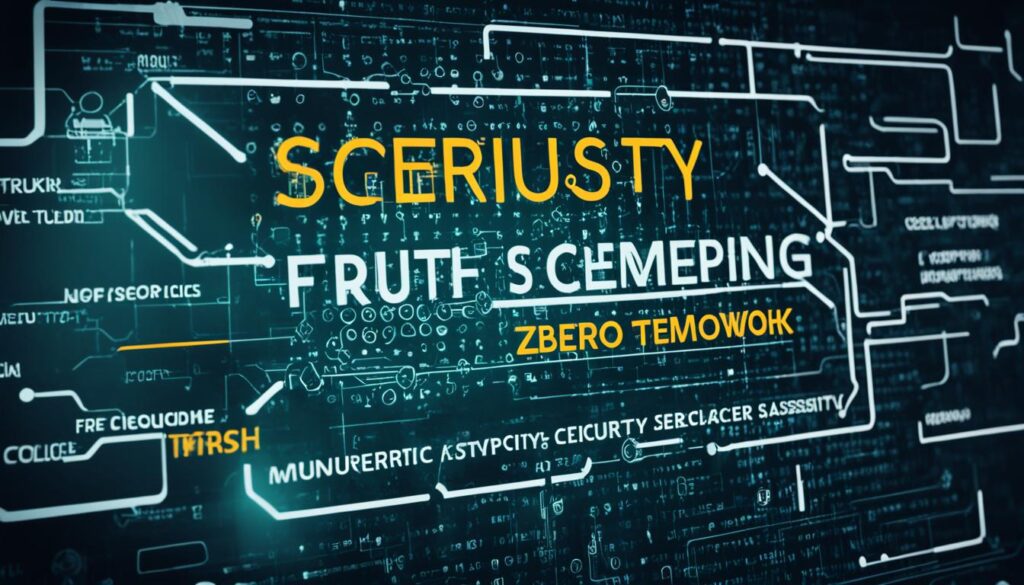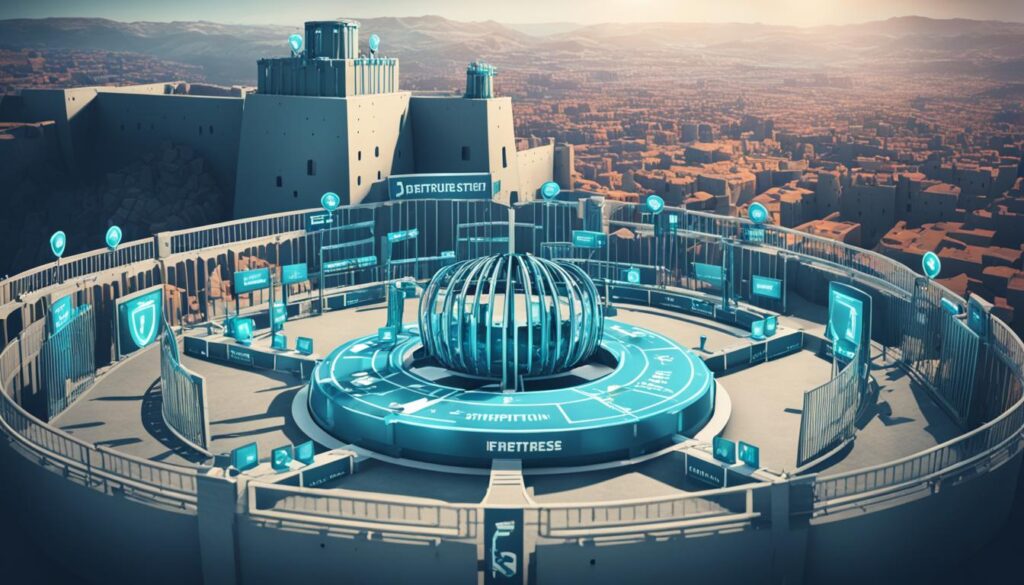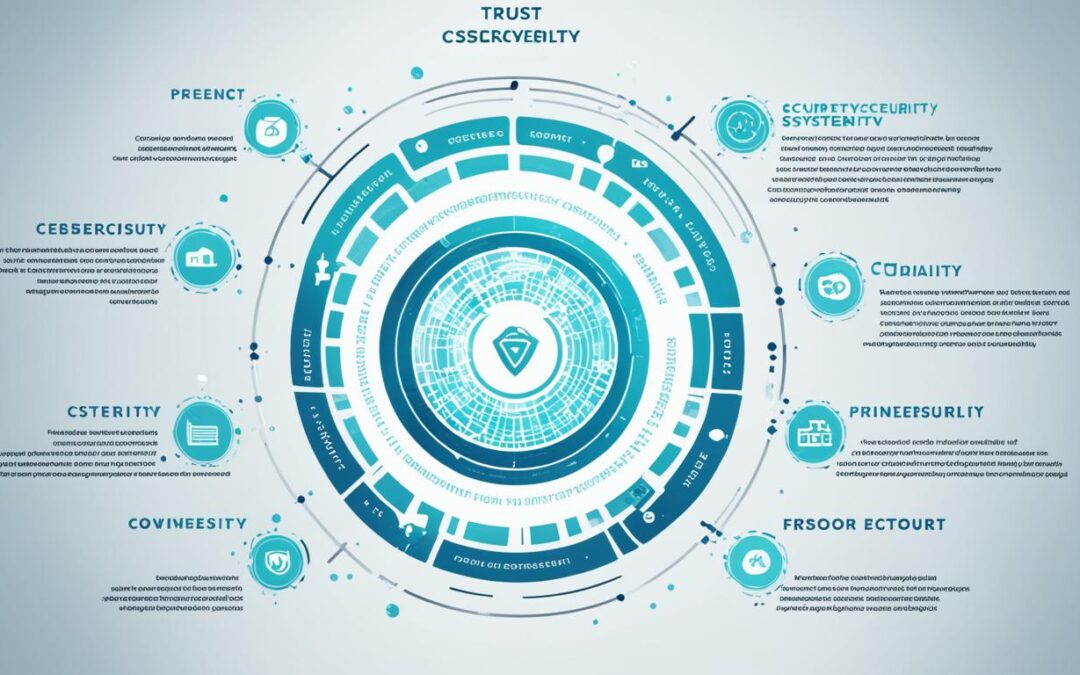In today’s world, cyber threats are growing fast. A big 66% of companies are now using zero trust cyber security to protect their digital stuff. This shows how old ways of keeping data safe are changing. Zero trust is becoming key for cyber defense strategies.
As we move more online, old ideas about security don’t work anymore. Zero trust cyber security is more than just a trend. It’s a way to build secure networks that can handle today’s complex cyber threats.
Switching to zero trust means changing how we think about security. It’s not just about updating tech. It’s about changing how we work to always check and limit access. This move is because we know threats can come from inside as well as outside. We’ll explore why “never trust, always verify” is key for staying safe online.
Key Takeaways
- Zero trust cyber security is quickly becoming a key part of cyber defense strategies.
- Old ways of fighting cyber threats are being replaced by zero trust to meet new challenges.
- Adopting zero trust means changing how we work and think, not just updating tech.
- A lot of businesses are starting to use zero trust architecture.
- Being secure today means being able to adapt and have secure networks that protect against all kinds of threats.
- The idea of zero trust changes how we see security, making us always check and verify.
Understanding the Zero Trust Model
In today’s world, cyber threats are getting more complex. We need to move from old security ways to new ones. The Zero Trust model changes how we think about keeping networks and data safe. It moves from “trust but verify” to “never trust, always verify”.
Defining Zero Trust Cybersecurity
Zero Trust is a new approach to keep data safe by not trusting anyone in the network. It uses “least privilege access” and checks every person and device before they can get to network resources. This is true whether they are inside or outside the network.
The Evolution of Security Paradigms
Before, security focused on keeping bad things out at the network’s edge. But now, threats come from inside and outside. Zero Trust offers a better way to protect data by using strict checks and new security plans.
Principles of Zero Trust Architecture
Zero Trust focuses on strict security, checking who and what is trying to get in, and keeping data safe in small groups. It treats every try to get into the network as a threat. This makes data and security better.
Why Traditional Security Measures Fall Short
In today’s digital world, cyber threats change fast. Traditional security often can’t keep up to protect our data well. We’ll look into why old ways of defending aren’t enough anymore. We’ll see why we need new strategies like secure networks, protecting data, and catching threats from within.
Limitations of Perimeter-Based Security
Old security methods focused on keeping the bad stuff out by building a wall around the network. But today, threats can come from both outside and inside. This old way can’t adapt quickly enough to today’s threats.
Inadequacies in Detecting Insider Threats
Finding threats from within is key to keeping data safe. But old security can miss these threats. It’s important to watch closely from the inside to catch these risks early.
The Rise of Sophisticated Cyber Attacks
Cybercriminals are getting smarter, and old security can’t keep up. We need strong network designs to fight these new threats. A strong network helps protect data and keeps security up to date with constant checks and quick responses.
We need to move to better, all-around security plans. Focusing on strong networks, watching for threats from within, and protecting data well is key. This is how we can fight cyber threats better today.
Zero Trust Cyber Security Cybersecurity Information Security
The Zero Trust model is changing how companies handle cyber security framework and protect data. It says no one inside or outside the network should be trusted right away. This change helps improve data privacy and boost threat detection.
Zero Trust frameworks need secure access controls to check who wants access and what they can see. This makes sure the right people get to the right resources at the right time for the right reasons. Adding these steps makes an organization’s cyber security stronger by offering more defense against attacks.

Zero Trust is more than just a theory; it works well in many IT settings. This flexibility is key for companies to keep up with strong security in a changing threat world. Here’s a look at what makes up a full Zero Trust approach focusing on cyber security, data privacy, and fighting threats.
| Element | Description | Impact on Security |
|---|---|---|
| Secure Access | Controls who can access the network and under what conditions. | Increases security by limiting potential points of entry for attackers. |
| Threat Detection | Rapid identification and response to potential threats. | Enhances the ability to prevent or mitigate cyber-attacks. |
| Data Privacy | Ensures that sensitive information is only accessible to authorized users. | Helps comply with legal regulations and protects against data breaches. |
| Access Control | Tools and protocols that determine access levels and permissions within a system. | Safeguards sensitive data and systems from unauthorized access and misuse. |
Going with a Zero Trust framework means more than just using new tech. It means changing how you think about security. By always checking and using the least-privilege access rule, companies can better protect themselves from today’s cyber threats.
Implementing a Zero Trust Strategy
In today’s digital world, we need advanced security measures and secure authentication more than ever. A Zero Trust strategy is key for better identity management and security incident response. It requires both tech updates and changes in how we think about data security.
Step-by-Step Approach to Zero Trust Adoption
Starting with Zero Trust means careful planning and understanding its core ideas. First, pinpoint sensitive data and track how it moves. Then, apply strict access controls step by step.
- Evaluate current security setup and spot important assets.
- Give users only the access they need for specific tasks.
- Keep an eye on and check security settings and standards all the time.
- Use automation to catch threats fast and improve security.
Secure Access Control Mechanisms
At the heart of Zero Trust is making sure users are who they say they are. Using multi-factor authentication (MFA), unified endpoint management (UEM), and next-generation firewalls is crucial. These tools help keep access secure by fitting well into the network.

| Feature | Description | Benefit |
|---|---|---|
| MFA | Requires multiple credentials for user verification. | Boosts identity security by adding more authentication steps. |
| UEM | Securely manages devices and apps across different places. | Makes device management easier while keeping it secure. |
| Next-gen Firewalls | Uses advanced tech and data analysis to stop threats. | Keeps up with modern threats with flexible rules and quick action. |
Step by step, Zero Trust helps reduce risks and boost security in businesses. It makes sure security incident response and identity management systems are strong against attacks. Moving to Zero Trust not only stops data breaches but also meets a company’s growing cybersecurity needs.
Technologies Powering Zero Trust Networks
Technology changes are making Zero Trust networks key in keeping data safe and stopping cyber threats. They use advanced systems for finding threats, strong identity checks, and the latest in machine learning and artificial intelligence. These tools are vital for secure networks to work well.
Advanced Threat Detection Systems
Artificial intelligence powers advanced threat detection systems. They analyze network traffic in real-time to stop cyber attacks. These systems spot unusual patterns that could mean a threat, keeping all access points secure.
Identity and Access Management (IAM) Solutions
IAM solutions are crucial for Zero Trust networks. They make sure every user and device is properly checked before accessing the network. By using machine learning, IAM gets better at catching unauthorized tries, making the network safer.
Machine Learning and AI in Zero Trust
Machine learning and artificial intelligence help Zero Trust networks stay secure and adapt to threats. They keep security rules up-to-date, reacting to new threats without hurting the system or user experience.
| Technology | Role in Zero Trust | Benefits |
|---|---|---|
| Machine Learning | Real-time Threat Detection | Enhanced pattern recognition and anomaly detection |
| Artificial Intelligence | Incident Response | Automated risk assessment and response activation |
| IAM Systems | Access Control | Secure authentication and authorization protocols |

Real-World Applications of the Zero Trust Framework
In today’s digital world, the Zero Trust framework is key for many sectors. It boosts cloud security and offers strong IT security solutions. This method is crucial for a secure infrastructure that meets today’s cybersecurity services needs and strengthens digital security. Let’s look at how Zero Trust works in different industries, showing its real benefits and how it can grow.

| Industry | Challenges | Zero Trust Implementation | Outcomes |
|---|---|---|---|
| Finance | High risk of data breaches and fraud | Comprehensive identity verification and encryption policies | Decreased fraudulent transactions and improved compliance |
| Healthcare | Sensitive data protection and regulatory compliance | Segmented access to patient records | Enhanced patient data security and HIPAA compliance |
| Retail | Protection of customer data across platforms | Real-time threat detection and response | Increased consumer trust and reduced data breach incidents |
| Government | Security of classified information against cyber threats | Restricted data access based on clearance level | Secure transfer of sensitive information, mitigating insider threats |
The examples show how Zero Trust boosts security in various sectors. It’s especially useful where old security methods don’t work well. By always checking and updating trust levels in digital interactions, companies can get a more secure IT setup.
Challenges in Migrating to Zero Trust Security
Switching to a zero trust security model is a big change. It requires updates in both tech and culture. This shift is key for a safer network setup but faces big challenges. These include integrating old systems and managing changes in the organization. We’ll look at these issues and how to tackle them when adding zero trust to current IT setups.
Handling Legacy Systems and Interoperability
Integrating old systems is a big hurdle in moving to zero trust security. These systems might not work well with today’s cyber security needs. To fix this, a careful plan is needed to either update or replace old tech without stopping work.
Organizational and Cultural Obstacles
Changing to a zero trust framework also means changing how the company thinks about security. It’s not just about training, but also changing how everyone sees security. This can be hard, especially in places where security was not a top priority before.
Strategies for Overcoming Implementation Barriers
To beat these challenges, having a detailed plan is key. This plan should include adding new security tech step by step, training, and checks to make sure everything fits with zero trust. Working with tech experts who know about secure networks can also make the switch smoother.
| Challenge | Strategy | Expected Outcome |
|---|---|---|
| Legacy System Constraints | Gradual integration of new technologies | Minimized disruptions, enhanced flexibility |
| Resistance to Cultural Change | Targeted training sessions | Improved security mindset across all departments |
| Technical Compatibility Issues | Collaboration with IT specialists | Seamless system functionality under Zero Trust |
Policies and Regulatory Implications for Zero Trust
Organizations are moving to a Zero Trust cybersecurity model to fight off advanced threats. This shift is key to understanding security compliance, security regulation, and policy creation. The “never trust, always verify” idea boosts security management and fits with current and new rules on data breach prevention.
Compliance with Security Regulations
Zero Trust frameworks work well with tough security laws like GDPR and HIPAA. These laws require strong data protection, which Zero Trust naturally offers. For example, Zero Trust’s least privilege principle reduces data risk and meets strict access rules.
Developing Zero Trust-aligned Policies
Creating policies that match Zero Trust means changing old security rules. It’s about using new tech and changing how people think. It means always checking access requests, no matter where they come from.
| Regulation | Requirement | Zero Trust Capability |
|---|---|---|
| GDPR | Data Protection | Encryption & User Authentication |
| HIPAA | Access Control | Secure Access Mechanisms |
| FISMA | Information Security Management | Continuous Monitoring & Risk Assessment |
Switching to Zero Trust strengthens an organization’s defense against unauthorized access. It also keeps them in line with the law, protecting sensitive data and systems from breaches.
Future Trends: The Evolution of Zero Trust Cybersecurity
Zero trust frameworks are changing how we think about cybersecurity. They are key to fighting cyber threats and building strong security cultures. Looking ahead, we see how zero trust will grow with new tech and digital changes.
Integrating Zero Trust with Emerging Technologies
Combining zero trust with tech like AI, blockchain, and IoT makes our defenses stronger. This mix helps spot and stop threats quickly, making our networks safer against new dangers.
The Expanding Scope of Zero Trust in Digital Transformation
As companies change digitally, zero trust is becoming more important. It’s not just a trend; it’s a key part of digital growth. Zero trust is moving into more areas of digital life to keep things safe and controlled. This means a future where zero trust is essential for staying strong online.
Conclusion
In today’s world, old security methods aren’t enough to fight cyber threats. The Zero Trust model is a key change in cybersecurity information security. It says we shouldn’t trust anyone right away and must check before giving access. This new way of thinking is vital for how companies protect themselves.
Zero Trust is being used in many areas and shows it works well. It helps stop unauthorized access and lets companies control who gets to use resources. Zero Trust is key for IT security solutions and helps prevent security issues.
It focuses on constant monitoring and strict rules for access. This way, security problems are stopped before they start. It helps companies stay strong against today’s complex cyber threats.
Using Zero Trust shows a company cares about keeping their digital world safe. As companies grow, adding Zero Trust to their cybersecurity information security plans is crucial. It helps protect data and keep IT systems safe. Zero Trust will keep shaping the future of IT security, setting a new standard for fighting cyber threats in our connected world.
In conclusion, cybersecurity solutions are essential in today’s digital landscape. With cyber attacks becoming more sophisticated and prevalent, it is important for businesses and individuals alike to prioritize cyber attack prevention through robust security measures. Implementing technologies like Zero Trust can significantly enhance risk mitigation strategies, ensuring that sensitive data remains protected.
Furthermore, the ever-evolving nature of cyber threats necessitates proactive measures and continuous evaluation of security protocols. It is crucial for organizations to stay informed about the latest cyber attack trends and adopt cutting-edge technologies to safeguard their systems and networks. Regularly updating security software, conducting penetration testing, and investing in employee training are all vital components of a comprehensive cybersecurity strategy.
Lastly, while cybersecurity solutions play a critical role in protecting against cyber threats, it is equally important to adopt a holistic approach that includes both technical and behavioral aspects. User awareness and adherence to best practices, such as strong password management and avoiding suspicious links and attachments, are fundamental in minimizing the risk of a successful cyber attack.
In summary, cyber threats continue to pose significant risks to individuals and organizations, making robust cybersecurity solutions and risk mitigation efforts more important than ever. By embracing new technologies like Zero Trust and staying vigilant in implementing and updating security measures, we can establish a safer digital environment for all.
FAQ
What is zero trust cybersecurity?
Zero trust cybersecurity means never trusting anyone or anything without checking first. It thinks threats can come from inside or outside the network. So, it checks every user and device before they can access network resources, no matter where they are.
How does the zero trust model differ from traditional security models?
Traditional security models focus on keeping the network safe and trust everything inside. But the zero trust model sees all users and devices as potential threats. It checks their trustworthiness before letting them into the network, making security more strict and flexible.
What are some of the principles of zero trust architecture?
Key principles include giving users only what they need, breaking the network into smaller parts, using more than one way to prove who you are, checking user and device identities, watching the network closely, and making access decisions based on risk. These help create a strong security system that keeps up with today’s cyber threats.
Why are traditional security measures no longer sufficient?
Old security methods assume everything inside is safe, which isn’t true anymore. We now face insider threats, remote work, and advanced cyber attacks that get past old defenses. We need a more detailed approach that fits today’s complex security needs.
How do zero trust strategies improve threat detection and data privacy?
Zero trust strategies boost threat detection by always checking user actions and device trust. This lets them quickly spot and act on threats. It also keeps data safe by controlling who can see it and when, reducing the chance of data leaks.
What is a step-by-step approach to adopting a zero trust strategy?
To adopt zero trust, first look at your current security, map how things connect, design a zero trust network, and make a plan for access control. Then, put in the zero trust tech, keep an eye on the network, and always look for ways to improve security.
What technologies are essential for a zero trust network?
Essential tech includes systems that spot and act on threats fast, tools for managing identities and access, and AI to analyze network data for security risks. These help make sure the network is safe and secure.
What challenges are associated with migrating to zero trust security?
Moving to zero trust can mean updating old systems, getting people on board with change, dealing with how different systems work together, and teaching people about zero trust. Good planning, talking with stakeholders, and adding new features step by step can help overcome these hurdles.
How does zero trust align with regulatory compliance requirements?
Zero trust fits well with rules about protecting data and controlling access. It makes sure only the right people can see sensitive information, helping meet standards like GDPR, HIPAA, and CCPA.
What are the future trends for zero trust cybersecurity?
The future looks bright for zero trust with more integration with new tech like IoT, blockchain, and 5G. It will play a big role in digital changes and keep evolving to fight new cyber threats. Zero trust will become a key part of cybersecurity as technology moves forward.

